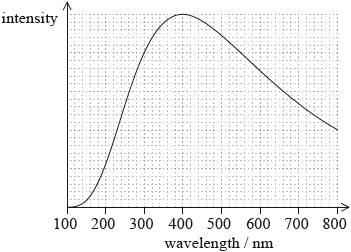| Date | May 2014 | Marks available | 2 | Reference code | 14M.3.SL.TZ2.12 |
| Level | Standard level | Paper | Paper 3 | Time zone | Time zone 2 |
| Command term | State | Question number | 12 | Adapted from | N/A |
Question
This question is about objects in the universe.
State one difference between
(i) a main sequence star and a planet.
(ii) a stellar cluster and a constellation.
State how
(i) it is known that main sequence stars are made predominantly of hydrogen.
(ii) a main sequence star remains in equilibrium despite it having a great mass.
The graph shows the variation with wavelength of the intensity of a main sequence star.

Calculate the surface temperature of this star.
Markscheme
(i) stars, and not planets, have cores undergoing fusion;
stars have much greater mass/luminosity/absolute magnitude/temperature than planets;
planets reflect starlight rather than emit;
planets in our solar system can show retrograde motion, stars cannot;
Allow other sensible answers.
(ii) stars in a stellar cluster are close to each other/kept together by gravitation, the stars in a constellation are not;
(i) the lines in the (absorption) spectrum of the star (correspond to hydrogen wavelengths);
(ii) the gravitational force that tends to collapse the star is balanced by a force due to radiation pressure;
peak wavelength is at 400 (nm); (accept answers in the range of 380 to 420 (nm))
\(T = \left( {\frac{{{\text{2.9}} \times {\text{1}}{{\text{0}}^{ - 3}}}}{{{\text{400}} \times {\text{1}}{{\text{0}}^{ - 9}}}} = } \right){\text{ 7250 (K)}}\); (accept answers in the range of 6900 to 7600 (K))
Award [2] for a bald correct answer.

